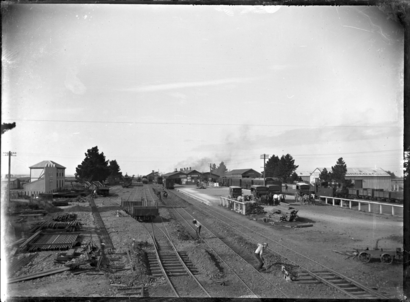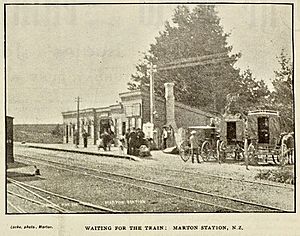Marton railway station, Manawatu-Wanganui facts for kids
Quick facts for kids
Marton railway station
|
||||||||||||||||
|---|---|---|---|---|---|---|---|---|---|---|---|---|---|---|---|---|

Marton Railway Station in 1909
|
||||||||||||||||
| Location | New Zealand | |||||||||||||||
| Coordinates | 40°05′13″S 175°23′28″E / 40.087°S 175.391°E | |||||||||||||||
| Elevation | 141 m (463 ft) | |||||||||||||||
| Line(s) | North Island Main Trunk | |||||||||||||||
| Distance | Wellington 180.25 km (112.00 mi) | |||||||||||||||
| History | ||||||||||||||||
| Opened | 4 February 1878 | |||||||||||||||
| Closed | passengers 25 June 2012 | |||||||||||||||
| Rebuilt | 1 June 1898 and 1 April 1965 | |||||||||||||||
| Electrified | June 1988 | |||||||||||||||
| Services | ||||||||||||||||
|
||||||||||||||||
Marton railway station was once a busy train station and a place where different railway lines met. It opened on 4 February 1878. The station served the town of Marton, which is the biggest town in the Rangitīkei District of New Zealand.
Over time, the station changed. When the main railway line (called the North Island Main Trunk or NIMT) was built, a new station was created south of the original one in 1898. The old station was then renamed and became less important. Today, the station is no longer used for regular passenger trains, but you might still see special excursion trains stop there sometimes. A special underground path for people to walk through to the station is still open.
Contents
How Marton's Railway Started
The first railway line to Marton was built to connect the ports of Foxton and Whanganui with the areas around them. This line opened in different parts.
Trains from Whanganui reached Turakina on 17 May 1877. The railway line was then extended to Marton, and trains started running there on 4 February 1878. People soon complained that the Marton station was too small and too far from the town centre.
The railway line connecting Foxton to Whanganui, passing through Marton, was fully open by 20 May 1878.
Marton Junction: A New Hub
A new railway hub, or "junction," was created at Marton when the line to Hunterville opened on 2 June 1888. This meant trains from that branch line would stop at the junction to move wagons around before going on to Marton.
In 1898, the main Marton station was moved to this new junction. This happened because there were big plans for the North Island Main Trunk (NIMT) railway, and Marton was becoming an important meeting point for different lines.
The Original Pukepapa Station
The first Marton station was renamed Pukepapa on 1 June 1898. It became a "flag station," which meant trains would only stop there if passengers waved a flag to get on or off. This old station was only for passengers and eventually closed on 10 August 1959.
The original station had several buildings added over time. By 1884, it had a station building, a shed for goods, a loading area, and yards for animals. It also had a platform for passengers and a special track where trains could wait for others to pass.
Developing the New Marton Junction Station
Plans for the new station at Marton Junction began in 1885. It included a station building, a shed for train engines, and a road to connect it to the town. The new station was ready by 27 July 1885.
At first, the new station platform had no shelter. A shelter was built between 1889 and 1891. By 1896, it had a shelter, a passenger platform, a crane, and a place for trains to refuel with coal and water. It also had a shed for engines and a track where 40 wagons could wait.
The station officially opened on 1 June 1898 and was simply called "Marton." By the end of 1898, it had a larger goods shed, loading areas, animal yards, and a special turning triangle for engines. It also had signals to control train movements and public toilets.
Over the years, more improvements were made. Railway houses were built for staff, and the stationmaster's house was improved. A post office and public telephone were available at the station from 1898 until 1934. The station area and engine shed were lit by gas in 1916. In 1929, a large turntable was built to turn engines around.
Marton station kept records of how many passengers and goods it handled each year. For example, in 1923, it had almost 49,000 passengers and a huge number of sheep and pigs coming in (over 53,000!).
In 1931, the station employed 15 full-time staff, plus many others who worked with locomotives, maintenance, signals, and traffic.
Refreshment Rooms
From 1898, Marton station had refreshment rooms where passengers could buy food and drinks. More rooms were added in 1901 and 1905. During World War I, when dining cars were removed from trains, a special dining room opened at Marton. From 1940 to 1954, there was even a hostel for female staff who worked in the refreshment rooms.
However, as trains became faster and new "railcars" were introduced, there was less need for long stops for refreshments. So, the refreshment rooms at Marton closed on 14 June 1954.
Station Rebuilding in the 1960s
In October 1963, work began to tear down the old station and build a new one. The old building was removed in August 1964, and the new, much larger station opened on 1 April 1965. Sadly, a third of this new station building was destroyed by fire on 1 April 1993.
A new depot for diesel engines and wagons was also built in 1966. It was made with a steel frame and corrugated aluminum.
Train Services
The first trains connected Marton and Whanganui starting on 4 February 1878, running twice a day. From 1879, the service was extended south to connect with the Feilding-Foxton line.
Many famous New Zealand passenger trains used to stop at Marton station. These included the New Plymouth Express, Night Limited, Scenic Daylight, Silver Star, Silver Fern, Blue Streak, Northerner, and Overlander. The first direct trains from Auckland to Wellington, which started on 14 February 1909, also stopped at Marton.
Freight Transport
Marton is still important for moving goods by train. For example, a company called Malteurop has two special railway tracks (sidings) south of Marton. Here, they make about 45,000 tons of malt each year, which is used for brewing. They also bring in barley from Timaru. Much of the malt is sent by train to breweries in Auckland.
In 2020, there were plans announced for a new $9.1 million rail hub focused on forestry products. The old goods yard, which was not being used in 2019, might be part of this new development.
Images for kids




